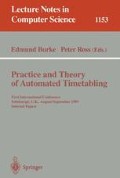Abstract
Employee timetabling problems (ETP) usually involve an organization with a set of tasks that need to be fulfilled by a set of employees, each with his/her own qualifications, constraints and preferences. The organization usually enforces some overall constraints and attempts to achieve some global objectives such as a just or equitable division of work. Examples for such problems are: assignment of nurses to shifts in a hospital, or assignment of phone operators to shifts and stations in a service-oriented call-center. One possible approach for solving ETPs is to use constraint processing techniques. Another approach is to model human knowledge into knowledge-based systems for timetabling. The present paper presents an approach to representing and processing employee timetabling problems (ETP) by a combination of explicit representations of some constraints in the network and rule-based processing in which specific heuristics for generic constraints of ETPs are embedded. The mixed-mode approach has been implemented in the form of a commercial software package for defining and solving real world ETPs. Example of a real world ETP is followed through the presentation and is used to experimentally compare standard CSP techniques with the proposed mixed-mode approach.
Preview
Unable to display preview. Download preview PDF.
References
D. Banks, A. Meisels, and P. van Beek. Timetabling constraint networks — representation and processing, 1995, Submitted to Workshop on AI and OR, January 1995.
B. Y. Choueiry and B. Faltings. Temporal abstractions and a partitioning heuristic for interactive resource allocation. In Notes of Workshop on Knowledge-based Production Planning, Scheduling and Control, IJCAI-93, pages 59–72, Chambery, France, 1993.
T. Dackie, J. Adhikary, D. R. Gaur, and K. Jackson. Backtrack-free search for resource allocation problems, 1995. Submitted to CONSTRAINT-95, January 1995.
R. Dechter and J. Pearl. Network-based heuristics for constraint satisfaction problems. Artificial Intelligence, 34:1–38, 1988.
M. C. Golumbic. Algorithmic aspects of perfect graphs. Annals of Discrete Mathematics, 21:301–323, 1984.
A. Meisels, J. El-Saana, and E. Gudes. Decomposing and solving timetabling constraint networks. Submitted to The AI Jou., 1994.
P. Prosser. Hybrid algorithms for the constraint satisfaction problem. Computational Intelligence, 9:268–299, 1993.
F. Rossi, C. Petrie, and V. Dhar. On the equivalence of constraint satisfaction problems. In Proceedings of the 9th European Conference on Artificial Intelligence, pages 550–556, Stockholm, Sweden, 1990.
G. Solotorevsky, E. Gudes, and A. Meisels. Raps — a rule-based language for specifying resource allocation and time-tabling problems. IEEE Trans. DKE, 6:681–698, 1994.
G. Trzewik, E. Gudes, A. Meisels, and G. Solotorevsky. Traps — time dependent resource allocation language. In Proceedings of the ECAI Workshop on Practical CSPs, pages 65–72, Amsterdam, 1994.
E. Tsang. Foundations of Constraint Satisfaction. Academic Press, 1993.
Author information
Authors and Affiliations
Editor information
Rights and permissions
Copyright information
© 1996 Springer-Verlag Berlin Heidelberg
About this paper
Cite this paper
Meisels, A., Gudes, E., Solotorevsky, G. (1996). Employee timetabling, constraint networks and knowledge-based rules: A mixed approach. In: Burke, E., Ross, P. (eds) Practice and Theory of Automated Timetabling. PATAT 1995. Lecture Notes in Computer Science, vol 1153. Springer, Berlin, Heidelberg. https://doi.org/10.1007/3-540-61794-9_53
Download citation
DOI: https://doi.org/10.1007/3-540-61794-9_53
Published:
Publisher Name: Springer, Berlin, Heidelberg
Print ISBN: 978-3-540-61794-5
Online ISBN: 978-3-540-70682-3
eBook Packages: Springer Book Archive

